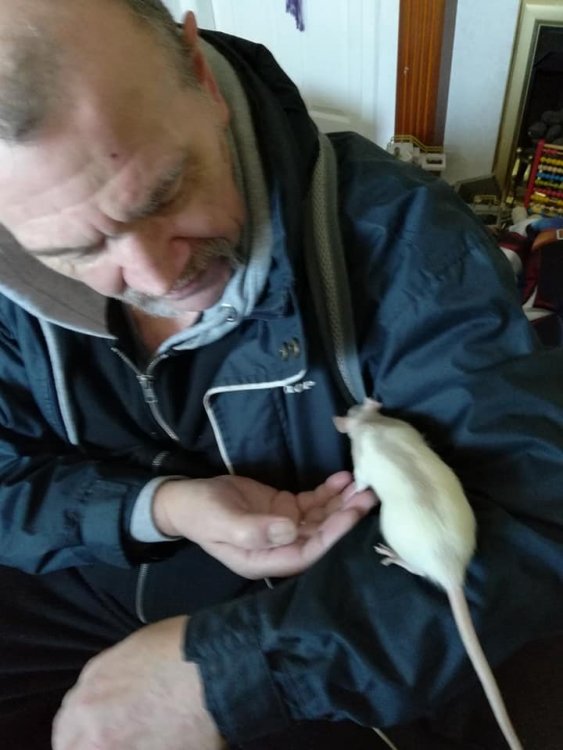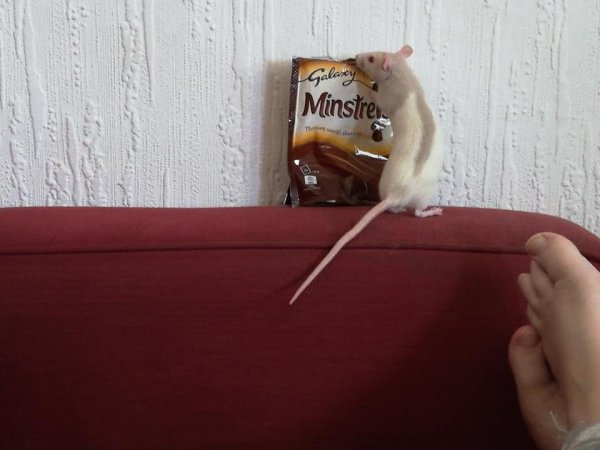-
Posts
20,847 -
Joined
-
Last visited
-
Days Won
49
Everything posted by CaaC (John)
-
Racism stinks to the high heavens buddy all over the world, a never-ending story, it would be a far, far better world if we could listen or read the news without a racist bastard going on about the colour of your skin or what nationality you were born as, racism fucks me off big time.
-
Hit the fucking pubs girls & guys quick smart, do a pub crawl and get a free pint.
-
New series started the other night a crime/drama and the first episode was good and a bit of a laugh called Wild Bill.
-
-
-
Liverpool manager Jurgen Klopp is willing to sell Egypt striker Mohamed Salah, 27 if Pepe comes to Anfield according to the BBC via Le10 Sport - in French)
-
Congratulations @Stick With Azeem next step is become a great, great, Uncle like me.
-
It's gotta be a photo shot added surely but saying that I would not mind being the rat where it was going
-
I would drink this a lot also, only because I supported the Aussie Football team, Carlton, the Blues, will be watching them live here at 10 ish when they play the Western Bulldogs.
-

Newcastle United Discussion
CaaC (John) replied to a topic in Premier League - English Football Forum
Newcastle United transfer news: Bin Zayed Group takeover doubts but Jose Mourinho links remain; shift in Rafa Benitez future odds plus Magpies miss out on £22m Brazilian The Bin Zayed Group takeover of Newcastle United, led by Sheikh Khaled, has reportedly been greeted with "scepticism" in the financial heart of the City of London. But that has not stopped the links to Jose Mourinho, with the Portuguese still keen on managing the Magpies, if Sheikh Khaled overthrows Sports Direct tycoon Mike Ashley. According to Sunday Times and Daily Record writer Duncan Castles, speaking on The Transfer Window podcast believes that the Abu Dhabi takeover is a "long shot" at St James's Park - but he thinks the Mourinho links are very real. "I can tell you that Jose Mourinho is interested to find out whether there is a possibility of Newcastle United being bought by a wealthy owner,” he said. “If it was, he would be interested in finding out whether that is an opportunity for him to manage again. “I think it’s a long shot, I think for the reasons we explained when we talked about that bid that’s been presented from a distant, relatively distant member of the Abu Dhabi royal family, that we had scepticism in the city of London as to whether a deal was actually in place.” Representatives of the Bin Zayed Group have released two separate statements on a potential takeover of United - with little to no communication coming from the club or the Premier League. Meanwhile, Rafa Benitez's contract has just 17 days to run and odds have tumbled on him becoming the new manager of former club Chelsea. Benitez was as high as 33/1 just a few days ago with some bookmakers but is now as short as 3/1 with Sky Bet, and is the second favourite behind Frank Lampard. Benitez would not be a popular choice with the fans but still has a very good relationship with owner Roman Abramovich and would definitely be a safe choice for the role, especially with the Blues set to be under a transfer embargo. https://www.shieldsgazette.com/sport/football/newcastle-united/newcastle-united-transfer-news-bin-zayed-group-takeover-doubts-but-jose-mourinho-links-remain-shift-in-rafa-benitez-future-odds-plus-magpies-miss-out-on-22m-brazilian-1-9821603 -
June 12, 2019 Table Salt Compound Spotted on Europa Tara Regio is the yellowish area to left of center, in this NASA Galileo image of Europa’s surface. This region of geologic chaos is the area researchers identified an abundance of sodium chloride. Credits: NASA/JPL/University of Arizona A familiar ingredient has been hiding in plain sight on the surface of Jupiter's moon Europa. Using a visible-light spectral analysis, planetary scientists at Caltech and NASA's Jet Propulsion Laboratory in Pasadena, California, have discovered that the yellow color visible on portions of the surface of Europa is actually sodium chloride, a compound known on Earth as table salt, which is also the principal component of sea salt. The discovery suggests that the salty subsurface ocean of Europa may chemically resemble Earth's oceans more than previously thought, challenging decades of supposition about the composition of those waters. The finding was published by Science Advances on June 12. Flybys from NASA's Voyager and Galileo spacecraft have led scientists to conclude that Europa is covered by a layer of salty liquid water encased in an icy shell. Galileo carried an infrared spectrometer, an instrument scientists use to examine the composition of a surface they're studying. Galileo's spectrometer found water ice and a substance that appeared to be magnesium sulfate salts (like Epsom salts). Since the icy shell is geologically young and features abundant evidence of past geologic activity, it was suspected that whatever salts exist on the surface may derive from the ocean below. "People have traditionally assumed that all of the interesting spectroscopy is in the infrared on planetary surfaces, because that's where most of the molecules that scientists are looking for have their fundamental features," said Mike Brown, the Richard and Barbara Rosenberg Professor of Planetary Astronomy at Caltech and coauthor of the Science Advances paper. In a laboratory simulating conditions on Jupiter's moon Europa at NASA's Jet Propulsion Laboratory in Pasadena, California, plain white table salt (sodium chloride) turned yellow (visible in a small well at the center of this photograph). The color is significant because scientists can now deduce that the yellow color previously observed on portions of the surface of Europa is actually sodium chloride. The JPL lab experiments matched temperature, pressure and electron radiation conditions at Europa's surface. Credits: NASA/JPL-Caltech "No one has taken visible-wavelength spectra of Europa before that had this sort of spatial and spectral resolution. The Galileo spacecraft didn't have a visible spectrometer. It just had a near-infrared spectrometer, and in the near-infrared, chlorides are featureless," said Caltech graduate student Samantha Trumbo, lead author of the paper. That all changed when new, higher spectral resolution data from the W. M. Keck Observatory on the dormant volcano Maunakea in Hawaii suggested that the scientists weren't actually seeing magnesium sulfates on Europa. Most of the sulfate salts considered previously possess distinct absorptions, which serve as fingerprints for compounds, that should have been visible in the higher-quality Keck data. However, the spectra of regions expected to reflect the internal composition lacked any of the characteristic sulfate absorptions. "We thought that we might be seeing sodium chlorides, but they are essentially featureless in an infrared spectrum," Brown said. Meanwhile, JPL scientist Kevin Hand had used sample ocean salts, bombarded by radiation in a laboratory under Europa-like conditions, and found that several new and distinct features arose in sodium chloride after irradiation. He discovered that they changed colors to the point that they could be identified with an analysis of the visible spectrum. Sodium chloride, for example, turned a shade of yellow similar to that visible in a geologically young area of Europa known as "Tara Regio." "Sodium chloride is a bit like invisible ink on Europa's surface. Before irradiation you can't tell it's there, but after irradiation the color jumps right out at you," said Hand. By taking a close look with the NASA/ESA Hubble Space Telescope, the research team was able to identify a distinct absorption in the visible spectrum at 450 nanometers, which matched the irradiated salt precisely, confirming that the yellow color of Tara Regio reflected the presence of irradiated sodium chloride on the surface. "We've had the capacity to do this analysis with the Hubble Space Telescope for the past 20 years," Brown said. "It's just that nobody thought to look." While the finding does not guarantee that this sodium chloride is derived from the subsurface ocean (this could, in fact, simply be evidence of different types of materials stratified in the moon's icy shell), the study's authors propose that it warrants a reevaluation of the geochemistry of Europa. "Magnesium sulfate would simply have leached into the ocean from rocks on the ocean floor, but sodium chloride may indicate the ocean floor is hydrothermally active," Trumbo said. "That would mean Europa is a more geologically interesting planetary body than previously believed." The study is titled "Sodium chloride on the surface of Europa." This research was supported by the NASA Earth and Space Science Fellowship Program, the Space Telescope Science Institute, and JPL, which is managed by Caltech for NASA. https://www.nasa.gov/feature/jpl/table-salt-compound-spotted-on-europa
- 1,657 replies
-
- space exploration
- astronomy
-
(and 1 more)
Tagged with:
-
This is what it looks like when galaxies are about to die Sarah Kaplan An illustration of a galaxy in the "cold quasar" phase. (University of Kansas) The beginning of the end of our galaxy is just a few billion years away. That’s when the glittering disk of the Milky Way is projected to smash into its nearest neighbor, a spiral galaxy called Andromeda. The force of the collision will fuse the black holes at the centers of the galaxies, producing a luminous whirlpool of fast-moving, ultrahot gas known as a quasar. Far from the galactic center, on a remote and unimportant planet called Earth, the quasar will initially appear as a brilliant blue halo in the sky, so bright it outshines the stars. But quasars are prone to cataclysmic flashes, which sweep gas and dust — the stuff that suns and worlds and life are made of — straight out into the circumgalactic medium. Eventually, the galaxy will empty itself of the material for making new stars. This is how all galaxies die — at least, according to the theories. But until now, no one has captured a galaxy in its transition phase, after the formation of a quasar but before it has lost all its stellar building blocks. In research presented Wednesday at the annual meeting of the American Astronomical Society in St. Louis, astrophysicist Allison Kirkpatrick announced the detection of 22 objects she calls “cold quasars.” These distant bodies glow bright enough to be beginning their death throes, Kirkpatrick said, but still contain cool clouds of dust, suggesting they haven’t yet lost the ability to birth new stars. They are right on the brink — hovering between the epoch of creation and the eon of waiting for death. “One of the biggest questions we have in astronomy is, how do galaxies die?” said Kirkpatrick, an assistant professor at the University of Kansas. “We know what they look like once they’re dead . . . but the rest of it is just pieces that we’ve guessed at.” Now, she continued, “we’ve found a population that we can study in detail and map out exactly how these galaxies move from their star formation phase of their life to their retirement phase." The discovery came during a survey of the brightest objects in the sky. Most such surveys examine X-rays produced by gas swooshing toward a black hole at close to the speed of light — exactly the kind of high-energy radiation you’d associate with a monstrously massive quasar. But Kirkpatrick also looked at these objects using infrared light, which emanates from much cooler phenomena, farther from galaxies’ violent cores. “Infrared detections . . . suggest very, very cold dust. That’s not something you typically expect to see,” Kirkpatrick said. Her next step will be to attempt to measure the speed at which gas and dust are being blown out of the galaxy, which will let Kirkpatrick calculate how long galaxies spend in the “cold quasar” phase. And she’ll continue to seek more of these objects, which offer a glimpse into a little-understood phase of galactic histories. “Astronomy is a unique science in that it’s passive,” she said. “We can’t watch any process in real time, so we are limited by snapshots of different galaxies we try to link together.” “The more we can fill in that picture with snapshots the better we can tell this story,” she said. “And I think I found a new snapshot.” https://www.msn.com/en-gb/news/techandscience/this-is-what-it-looks-like-when-galaxies-are-about-to-die/ar-AACQ2sN?li=AAnZ9Ug
- 1,657 replies
-
- space exploration
- astronomy
-
(and 1 more)
Tagged with:
-
@nudge @Bluewolf NASA spots "Star Trek" Starfleet logo on Mars Sophie Lewis NASA's Mars Reconnaissance Orbiter (MRO) has spotted an unusual symbol on the surface of Mars — the iconic "Star Trek" Starfleet logo. The MRO captured a series of strange chevron symbols on a Martian sand dune in the southeast Hellas Planitia region. The MRO HiRISE (High-Resolution Imaging Science Experiment) camera team at the University of Arizona highlighted the discovery Wednesday, though the image was acquired by the team April 22. "Enterprising viewers will make the discovery that these features look conspicuously like a famous logo," the camera team behind the MRO HiRise image said. According to the team, the shapes on the red planet were created by wind, lava and dunes. They began as large, crescent-shaped dunes that were surrounded by lava after an eruption before solidifying. As wind blew over the dunes, it displaced much of the sand, and eventually left behind "footprints," also called "dune casts," that record the presence of dunes that were surrounded by lava. Latest shots from the Mars Reconnaissance Orbiter The MRO has been exploring Mars from orbit since 2006, capturing some of the most detailed images of its surface. Hopefully, it finds some aliens sporting Vulcan salutes next. https://www.msn.com/en-gb/news/techandscience/nasa-spots-star-trek-starfleet-logo-on-mars/ar-AACR14W?MSCC=1560497143&ocid=chromentp
-
Lol, I think I have your answer, I lived in Victoria, Australia and I did drink beer, lagers out there called Victorian Bitters
-
That photo looks like the former Australian captain Ricky Ponting? but saying that it depends what cricket jumper you like, V neck or whatever Edit. I was right, that was Ricky Ponting, the name came under when I Googled it lol, one of the great Australian (former) captains of years gone by, not like the shitty Aussie captains nowadays.
-
Going back to that @Spike this might throw some light onto your question. Cricket Whites
-
I am a bit lost with the question really if that picture is of Australian International Cricketers it could mean they play for Victoria, a State in Australia as they do have State matches out in kangaroo land i.e Victoria v New South Wales, I could be wrong though?
-
Another game rained off zzzzzzzzzzzzzzzzzzzzzzzzzzzzzzzzzzzz
-
THAT'S IT, proves that everyone has been doing it!!!! The earliest evidence for cannabis smoking discovered in ancient tombs Michelle Z. Donahue 2,500-year-old burials at Jirzankal Cemetery in western China feature wooden braziers that burned cannabis plants containing an unusually high level of the psychoactive chemical THC. The earliest direct evidence for human consumption of cannabis as a drug has been discovered in a 2,500-year-old cemetery in Central Asia, according to a research paper published today in the journal Science Advances. While cannabis plants and seeds have been identified at other archaeological sites from the same general region and time period—including a cannabis ‘burial shroud’ discovered in 2016—it’s been unclear in each context whether the versatile plant was used for psychoactive reasons or for other ritual purposes. An international team of researchers analyzed the interiors and contents of 10 wooden bowls excavated from burials at Jirzankal Cemetery, a site on the Pamir Plateau in what is now far-western China. The bowls contained small stones that had been exposed to high heat, and archaeologists identified them as braziers for burning incense or other plant matter. When chemical analysis of the braziers revealed that nine of the ten once contained cannabis, the researchers compared the chemical signature of the samples against those of cannabis plants discovered 1,000 miles to the east at Jiayi Cemetery, in burials dating from the eighth to the sixth century B.C. They saw that the Jirzankal cannabis had something the Jiayi hemp did not: Molecular remnants of tetrahydrocannabinol, or THC—the chemical responsible for cannabis’ psychoactive effects. The strain of cannabis found at Jiayi does not contain THC and would have been primarily been used as a source of fibre for clothing and rope, as well as a nutrient-rich oilseed. The Jirzankal cannabis features higher levels of mind-altering compounds that have yet been found at any ancient site, suggesting that people could have been intentionally cultivating certain strains of cannabis for a potent high, or selecting wild plants known to produce that effect. Cannabis is known for its “plasticity,” or ability for new generations of plants to express different characteristics from earlier generations depending on exposure to environmental factors such as sunlight, temperature, and altitude. Wild strains of cannabis growing at higher altitudes, for instance, can have a higher THC content. While the researchers are unable to determine the actual origin of the cannabis used in the Jirzankal burials, they suggest that Jirzankal’s elevation some 10,000 feet on the Pamir Plateau may have put people in close proximity to wild strains with higher THC content—or that the cemetery could have been sited at that elevation for ease of access to desirable strains. Robert Spengler, director of paleoethnobotany laboratories at the Max Planck Institute for the Science of Human History and study co-author, says that the constant stream of people moving across the Pamir Plateau—an important crossroads connecting Central Asia and China with southwest Asia—could have resulted in the hybridization of local cannabis strains with those from other areas. While hybridization is another factor known to increase psychoactive cannabis strains’ THC potency, the question of whether it was intentional, or just by happy accident, is also still unclear. According to Spengler, this new study demonstrates that already 2,500 years ago, humans were potentially targeting specific plants for their chemical production. “It’s a wonderful example of how closely intertwined humans are and have been with the biotic world around them, and that they impose evolutionary pressures on the plants around them,” he says. The discovery at Jirzankal also provides the first direct evidence that humans inhaled combusted cannabis plants in order to obtain its psychoactive effects. No evidence of smoking pipes or similar apparatus has been found in Asia before contact with the New World in the modern era, but the inhalation of cannabis smoke from a heat source is described by the fifth-century B.C. Greek historian Herodotus, who described in his Histories how the Scythians, a nomadic tribe living on the Caspian Steppe, purified themselves with cannabis smoke after burying their dead: “The Scythians then take the seed of this hemp and, crawling in under the mats, throw it on the red-hot stones, where it smoulders and sends forth such fumes that no Greek vapour-bath could surpass it. The Scythians howl in their joy at the vapour-bath.” Herodotus also notes that the cannabis plant “grows both of itself and having been sown,” which University of North Carolina classics expert Emily Baragwanath says is usually interpreted as meaning the plant was cultivated—lending credence to the researcher’s ideas about purposeful cannabis hybridization. “People have been sceptical of Herodotus’ ethnographies of foreign peoples," she adds, "but as archaeology looks closer, it keeps finding affinities between the real world and what’s in the Histories.” Mark Merlin, an ethnobotanist and cannabis historian at the University of Hawaii at Manoa, says the wide diversity in cannabis around the world today is a testament to how long people have been involved with the plant and harnessed its many uses. “It’s a real indication of how long humans have been manipulating cannabis,” he says. https://www.msn.com/en-gb/news/offbeat/earliest-evidence-for-cannabis-smoking-discovered-in-ancient-tombs/ar-AACNJxA
-

Manchester United Discussion
CaaC (John) replied to a topic in Premier League - English Football Forum
-
-
Artificial islands in Scotland date back to 3700BC, scientists discover Harry Cockburn Mysterious man-made islets found in lochs on Scotland’s remote Outer Hebridean islands may be thousands of years older than previously realised, a study has revealed. The artificial structures, which are typically between 10 and 30 metres in diameter, are known as crannogs and are now usually covered with vegetation as no grazing animals can reach them. There are numerous examples of crannogs on Scotland’s rugged west coast and on the islands of the Outer Hebrides. They are frequently made of timber and stone and are occasionally built on existing rocky structures. While it had been thought they dated from no earlier than the Iron Age – around 1400 – 500BC – new research indicates crannogs were a common feature in bodies of water during the Neolithic epoch, which covers the time period from around 4000 to 2500 BC. But the late 20th Century discovery that the crannog of Eilean Dòmhnuill on the Outer Hebridean island of North Uist dated from around 3700BC prompted speculation among historians that the age of many other Scottish crannogs could have been severely underestimated. Now, mounting evidence suggests other crannogs in the area are equally as old. In 2012, a former Navy diver named Chris Murray discovered numerous examples of well-preserved pottery made in a style dating from the Neolithic period while diving at a crannog on the nearby Outer Hebridean Isle of Lewis. After the find, he teamed up with Dr Duncan Garrow from the University of Reading and they found further Neolithic pots at other Outer Hebridean crannogs. © Provided by Independent Digital News & Media Limited The crannog of Eilean Dòmhnuill on the Outer Hebridean island of North Uist dates from the Neolithic period (Richard Law) Since 2012 hundreds of pots have been found in the waters around the artificial islands, many of them well preserved. Eight radiocarbon dating measurements were taken from the structural timbers used in the building of four crannogs on the Isle of Lewis, with six falling within the Neolithic era ranging from 3640–3360BC. The research also reveals for the first time that the pots were likely to have been intentionally placed in the water around the crannogs – though it is not yet known why. The paper says: “The quantities of material now identified around several sites, and the position of these vessels in relation to the islets, suggests that pots were intentionally deposited into the water. Many vessels had substantial sooting on their external surfaces, and some had internal charred residues; they had clearly been used before deposition. The large fragment sizes of these vessels suggest that at least some, and possibly all, of the vessels, were complete when they entered the water.” Recent scholars assessing the original function of the crannogs “have suggested that they could have been special places associated with social gatherings, ritualised feasting and commensality (eating together),” the study says. “They would have required a huge investment of labour to build and probably remained significant places for a long time. Such islets may well have represented substantial symbols for, and of, the communities that constructed them,” Dr Garrow writes. “These islets could also have been perceived as special places, their watery surroundings creating separation from everyday life.” https://www.msn.com/en-gb/news/uknews/artificial-islands-in-scotland-date-back-to-3700bc-scientists-discover/ar-AACMESX














.png.777916a1654d0c65867ae09876fce905.png)


.thumb.png.86d6756bb931785920b22c2e4c536c44.png)
